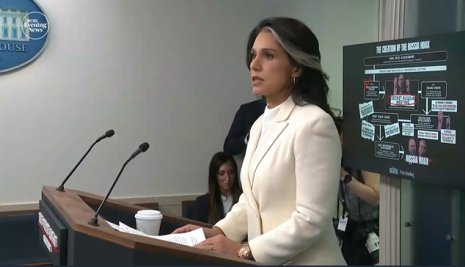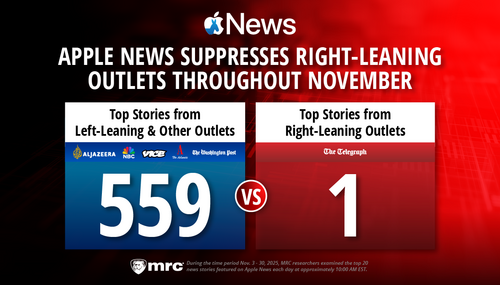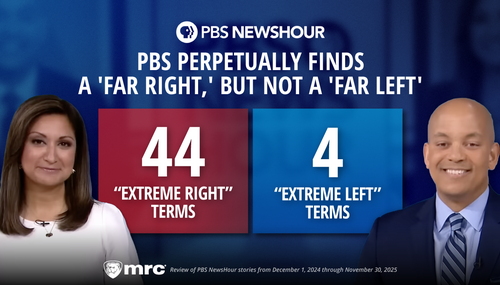Director of National Intelligence Tulsi Gabbard just dropped a memo that shatters the foundation of the Russiagate conspiracy theory and vindicates what Twitter, Facebook, and Google had told Congress years ago—there was no widespread, coordinated Russian campaign to swing the vote in 2016.
While legacy media and Washington insiders sold the story of alleged Russian interference to the public, internal records and public testimony from tech giants consistently told a different story. Twitter, Facebook and Google repeatedly refuted the idea that Russia had interfered in the final results of the 2016 presidential election.
Facebook CEO Mark Zuckerberg called the notion that so-called “fake news” on Facebook swayed the election a “pretty crazy idea,” pointing to the fact that this was “a very small amount of the content.” And Google's general counsel Kent Walker did not even name Russia in his written congressional testimony about the supposed interference campaign on YouTube. “[T]hat activity appears to have been limited on our platforms,” he said.
After billionaire Tesla owner Elon Musk bought Twitter, he opened the floodgates to The Twitter Files, which corroborate Gabbard’s memo.
For example, independent journalist Matt Taibbi noted in Twitter Files Part 11 that, “In September 2017, after a cursory review, Twitter informed the Senate it suspended 22 possible Russian accounts, and 179 others with ‘possible links’ to those accounts, amid a larger set of roughly 2700 suspects manually examined.” The day after this briefing to the Senate Select Committee on Intelligence, then-ranking member Sen. Mark Warner (D-VA) called the results “frankly, inadequate on almost every level" in comments to Reuters.
So Twitter went even further, forming a “Russia Task Force” to dig for evidence that Russia’s Internet Research Agency (IRA) was behind a coordinated influence campaign. But by October 13, 2017, the verdict, at least inside Twitter, was clear: “we see no evidence of a coordinated approach, all of the accounts found seem to be lone-wolf type activity (different timing, spend, targeting, <$10k in ad spend).”
Ten days later, after completing a manual review of 2,500 accounts, the task force concluded: “[W]e think this is exhaustive.” The task force noted, “Out of [2500 accounts] we’ve identified 32 suspicious accounts and only 17 of those are connected with Russia, only 2 of those have significant spend one of which is Russia Today and the remaining are <$10k in spend.”
These findings were consistent—but inconvenient for the leftist media narrative. Under mounting pressure from the Senate Select Intelligence Committee and legacy media outlets, Twitter changed its “methodologies” and expanded its net to include more accounts, ultimately inflating the number to 3,814, according to YouTuber and journalist Matt Orfalea in The Twitter Files Part 21.
Behind the scenes, even Twitter leadership knew evidence for flagging the accounts was shaky at best. Then Twitter Public Policy VP Colin Crowell made his concerns clear in an email update to his colleagues. “I’d like to caution that we should be exceedingly cautious in asserting that any accounts are ones we know are IRA accounts with certainty. We do not have 100% confidence in such determinations & no realistic way of knowing this from a Twitter-centric basis,” he wrote. Crowell also admitted the platform was relying on third-party assessments to make its claims.
Facebook, too, it seems, initially found little evidence supporting the Intelligence Community’s narrative. In a September 2017 blog post the company stated it had discovered “approximately $100,000 in ad spending from June of 2015 to May of 2017 — associated with roughly 3,000 ads — that was connected to about 470 inauthentic accounts and Pages in violation of our policies.”
Advisor and son-in-law of President Donald Trump Jared Kushner characterized the ad spending from alleged Russian accounts as negligible. "They said they spent $160,000. I spent $160,000 on Facebook in three hours during the campaign," he said. "If you look at the magnitude of what they did and what they accomplished, I think the ensuing investigations have been way more harmful to our country." For perspective, Axios reported that the Trump and Clinton campaigns spent “roughly $450 million” on Facebook ads.
For his part, MRC VP for Free Speech America Dan Schneider also called out the absurdity of the left’s Russia hoax. “For the price of an RV camper, Democrat leaders are trying to claim that Russia was trying to interfere in a $2.4 billion election,” said Dan Schneider. “That’s less than half a penny on the dollar. This is an absurd proposition, and these same Democrats now have egg on their face.”
When Facebook General Counsel Colin Stretch testified before the House Judiciary Committee in November, he expanded on that finding. “Our analysis also showed that these accounts used these ads to promote the roughly 120 Facebook Pages they had set up, which in turn posted more than 80,000 pieces of content between January 2015 and August 2017,” he wrote in his written testimony. It is unclear, however, whether Facebook, like Twitter, found a way to inflate the number to satisfy government officials hounding the company.
Google, for its part, reported even less evidence of interference. During the same November hearing, Google General Counsel Kent Walker made similar claims about YouTube, noting two ad accounts and 18 channels “with roughly 1,100 videos, a total of 43 hours of content, uploaded by individuals who we suspect are associated with this effort and which contained political content.” He added, “These videos generally had very low view counts; only around 3% percent had more than 5,000 views.”
Each of the platform’s evaluations of foreign influence campaigns matched the intelligence community’s assessments prior to the 2016 election, as Gabbard’s memo uncovers. “There is irrefutable evidence that detail how former President Barack Obama and his national security team directed the creation of an intelligence community assessment that they knew was false,” Gabbard said during the July 23 White House press briefing. “They knew it would promote this contrived narrative that Russia interfered in the 2016 election to help President Trump win, selling it to the American people as though it were true — it wasn't.”
In the months before the 2016 election, officials repeatedly found “no indication of a Russian threat to directly manipulate the actual vote count,” internal intelligence documents reveal.
In fact, there was so little evidence of Russian interference that on Sept. 2, 2016, an FBI official took issue with the wording of a President’s Daily Brief because of how it described Russia’s possible intentions, Gabbard’s memo uncovered. “The way it currently reads, it would indicate that we have definitive information that Russia does intend to disrupt our elections and we are uncomfortable making that assessment at this point.” [Emphasis added.]
In another email exchange, a Homeland Security official likewise agreed with ODNI that “Russia is not (and will not) trying to influence the election by using cyber means to manipulate computer-enabled election infrastructure.” Similar language was carried through in at least two follow-up assessments.
In early December 2016, another daily brief prepared for then-President Barack Obama reaffirmed “foreign adversaries did not use cyber attacks on election infrastructure to alter the US Presidential election outcome.” The brief was never published, as the FBI, led by then-Director James Comey, refused to be listed as a coauthor and even planned to write a dissent.
On December 9, “The Obama White House gathers top cabinet officials for a National Security Council Principals Committee (PC) Meeting,” including Comey and other top intelligence brass. Their resulting task wasn’t to determine if Russia meddled in the election but to figure out what evidence could be used to say it did.
The following week, the intelligence community began leaking wild claims of Russian election interference. This also marked the last entry in the Christopher Steele Dossier put together to link Trump to Russian President Vladimir Putin and his alleged election interference campaign.






